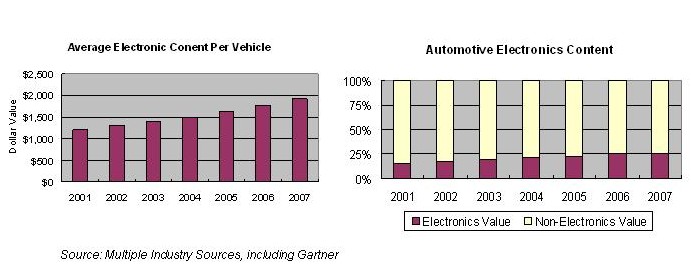1. Economic - Even the casual observer will notice how electronics pricing has plummeted over the past 10 years. While most people observe that this change has resulted in cheaper and more powerful PCs and consumer electronics, many people miss out on the point that it also means that electrical systems can be used economically in areas where they have never been used before - such as mechanical systems.
2. Safety - Automobile fatalities are one of the leading causes of death in developed countries and a combination of consumer demand and government regulation have driven automobile manufacturers to develop new safety systems for cars. Invariably, these systems are electronic control systems that monitor and provide feedback to the driver or over the car itself. Examples include anti-lock brake systems (ABS) which need a microcontroller, air bags which need an accelerometer and microcontroller and Tire Pressure Controllers (TPS) which use sensors and potentially a wireless communication system.
3. Consumer Demand - Consumers want their cars to be easy to control, easy to operate, comfortable and entertaining. These demands have driven manufacturers to add a variety of systems to automobiles that actually have no direct effect on the car's driving - keyless entry systems, Global Positioning Systems (GPS), and power windows, just to name a few.
While there are several ways to segment these electronic systems, I have put them into the following four groups:
Infotainment - Entertainment and information systems for the driver. These include the mundane, such as the ubiquitous radio, but also include new systems such as "Telematics", of which OnStar is the currently the most popular system. Examples: Audio Deck, Satellite Radio (XM Radio, e.g.), GPS, Telematic Systems, in-car Video (including rear-seat entertainment), Networked Car (wireless links for everything from your cellphone output to your car speaker to internet connectivity)
Powertrain - refers to the system in a car that controls the actual movement of the vehicle, including engine management. Historically, these systems have been hydraulic or mechanical, but with the introduction of fuel injection engines and the need for exhaust control, electronics made their debut in the powertrain and over time have increased their presence: Examples: Engine Control Unit (ECU), Adaptive Cruise Control, Power Steering
Control & Comfort - Dashboard Cluster, Heads Up Display, Remote Keyless Entry, Climate Control, Power Seats & Windows
Safety - Anti-lock Brakes, Traction Control, Airbags, Electronic Brakes, Tire Pressure Controllers
These are all systems that are in cars today and don't include a large number of systems in test-cars or on the drawing board such as collision avoidance systems, drive-by-wire, and other innovations which will increase the electronic content even further.
These systems are adding to a steady increase in the amount of electronics in the average automobile, despite the fact that electronics are getting cheaper:

So, what does this all mean?
o For the average consumer, it just means that your car will just become pretty darn nice, very safe, and much easier to control.
o The replacement of mechanical systems with electrical systems makes the car lighter, thus improving gas mileage.
o While more gas efficient, all these new systems require additional power that will not be manageable with the existing 12/14V battery system. According to Gartner, current 12/14V alternators can deliver up to 2 kilowatts of peak power, with the battery lending an additional 4 kilowatts peak power. A loaded, upscale vehicle could require as much as 12 kilowatts, and by 2010 this number could reach 20 kilowatts, fueling the need for higher voltages. Several manufacturers are exploring new battery and power systems for new cars which are likely to start hitting the street by the end of the decade.
o I would argue that as the average car becomes more electronic, that transitioning from the internal combustion engines to Hybrid Electrical Vehicles (HEV) or to full Electric Vehicles becomes easier from a design and manufacturing standpoint, and in consumer acceptance. The main issue in this area, however, will continue to be infrastructure.
o From a business standpoint, it means that those companies that are providing hydraulic and electrical systems need to diversify into electronics as soon as possible (this is not an issue with the vast majority of the "Tier 1" suppliers in this industry). In addition, it provides an opening for electronics providers who do not serve this market to get into one of the last, large manufacturing segments left in North America.
It should be remembered that the automotive industry is one of the largest industries in North America, contributing over 3% to the U.S. $10 Trillion Gross Domestic Product (GDP) and U.S. automakers collectively purchase nearly $120 billion of goods and services. Both domestic and foreign manufacturers have set up manufacturing or subassembly sites in nearly every state, and unlike other industries, U.S. domestic production is not going overseas. In fact, production in the U.S. is expected to increase by over a million units within the next five years to 17 million units. However, the U.S. percentage of worldwide production will decline somewhat, dropping from 29% in 2002 to 27% by 2007.
If possible, manufacturers should try to participate in this market, but certain structural changes taking place in the automotive supply chain are making this difficult, which I will go into more detail on a future posting.

No comments:
Post a Comment